Analyses of a Lake Dust Source in the Middle East through Models Performance
Abstract
:1. Introduction
2. Materials and Methods
2.1. Study Area
2.2. In-Situ Data
2.3. Satellite Products
2.4. Models
3. Results
3.1. Emerging Dust Source Investigation
3.2. Case Study (26–29 October 2017)
3.2.1. Reported Station Data
3.2.2. Satellite Products
3.2.3. Model Outputs
4. Conclusions
Author Contributions
Funding
Data Availability Statement
Acknowledgments
Conflicts of Interest
Appendix A. Synoptic Investigation of the Dust Storms

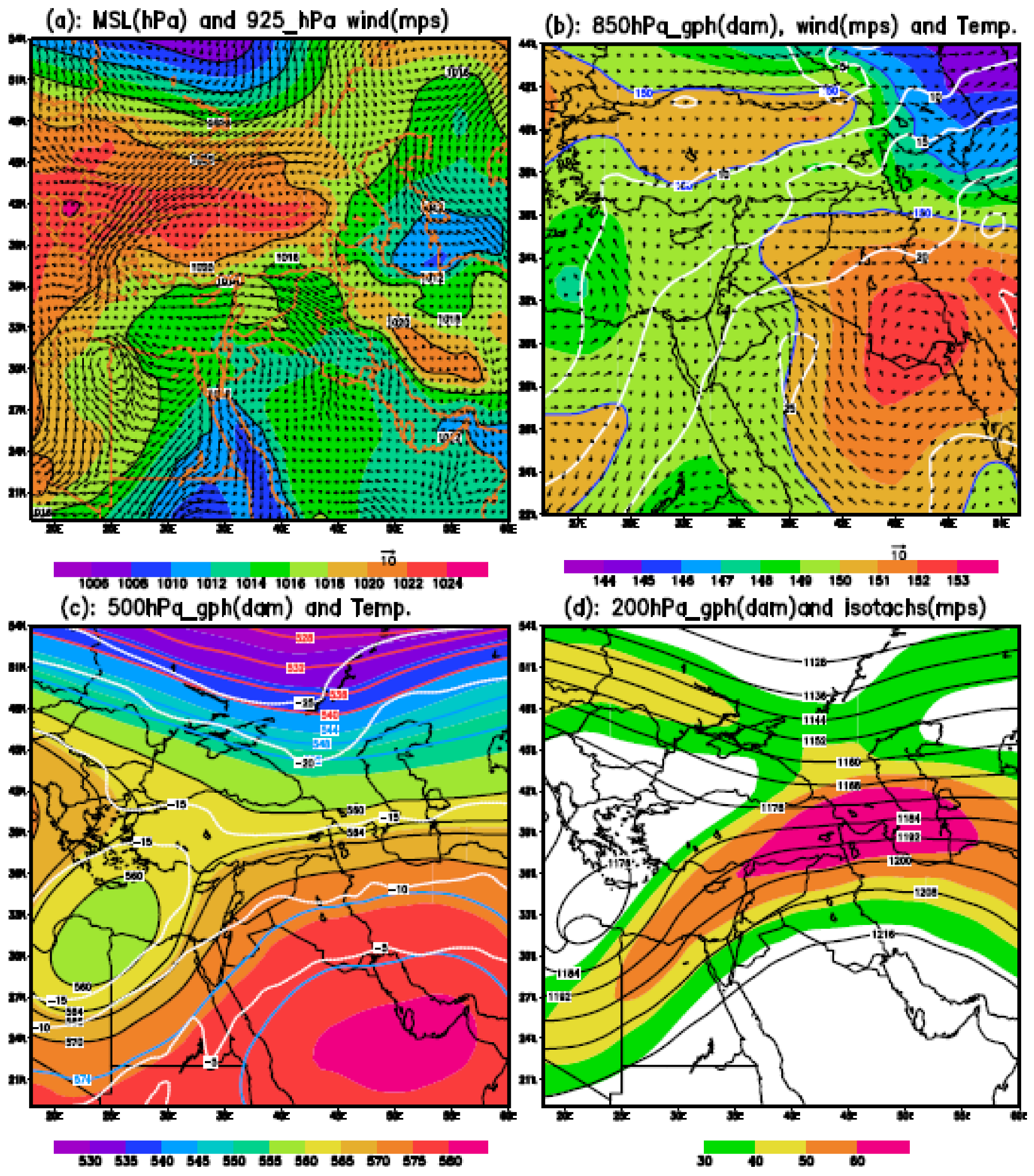
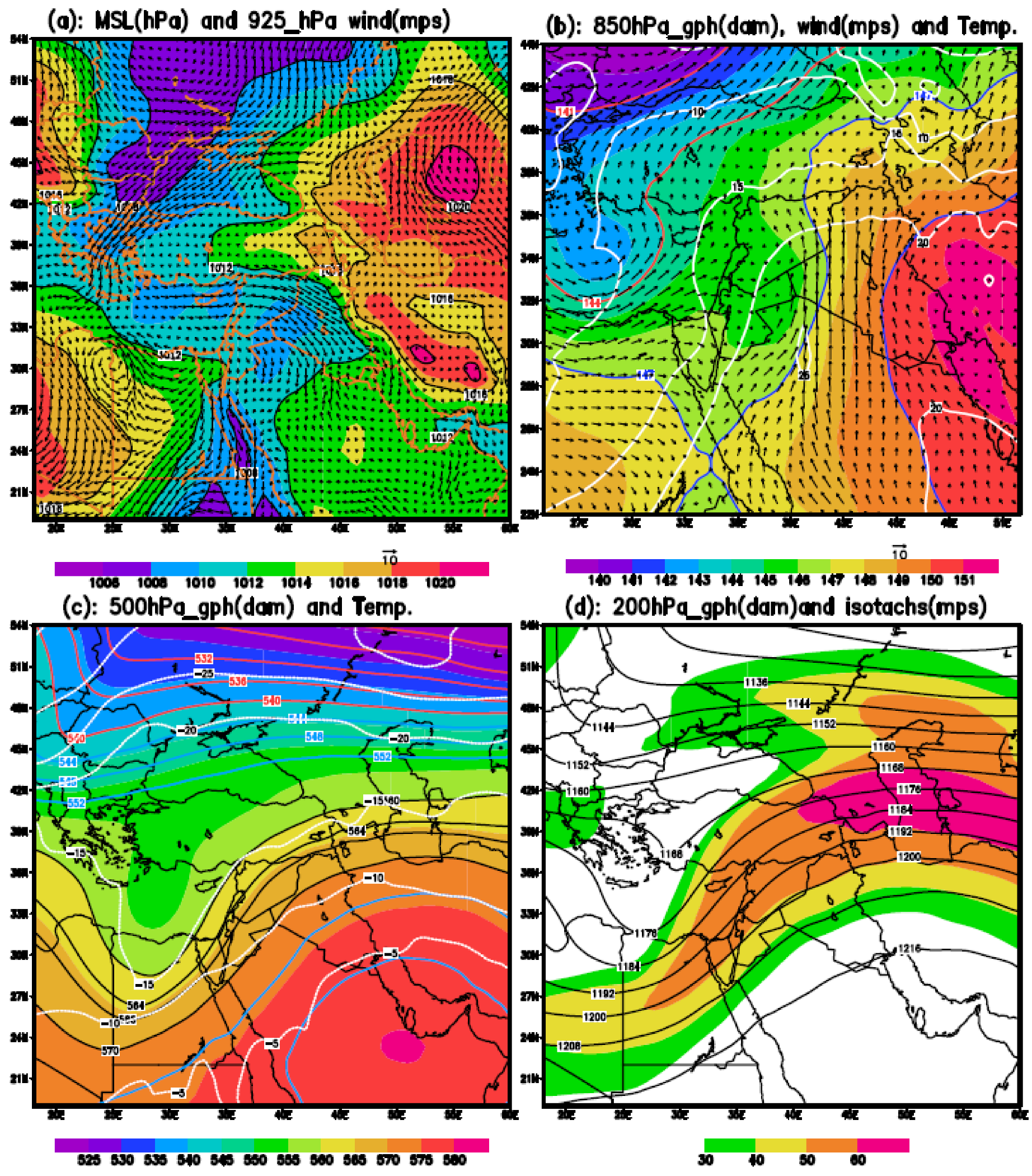
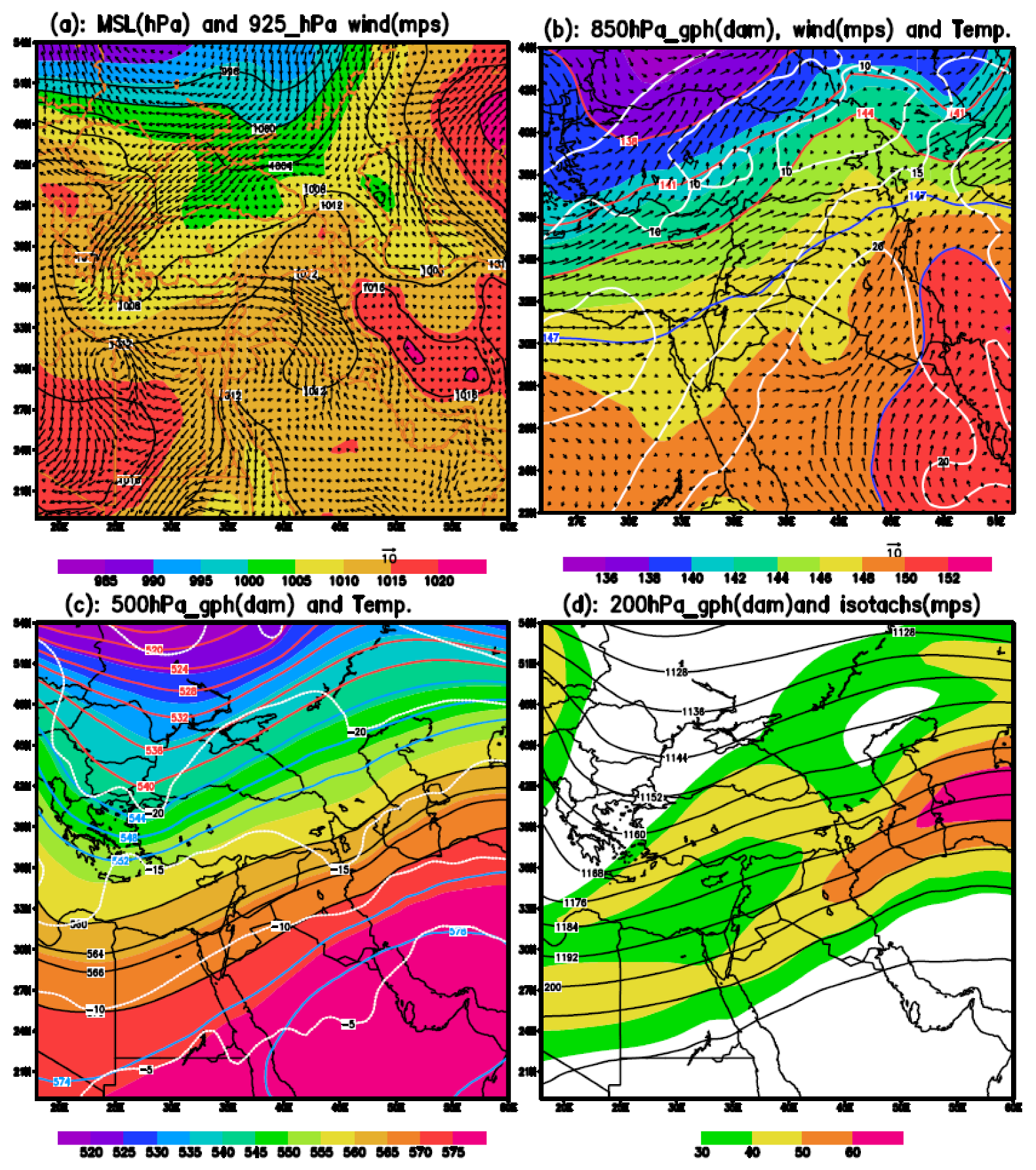
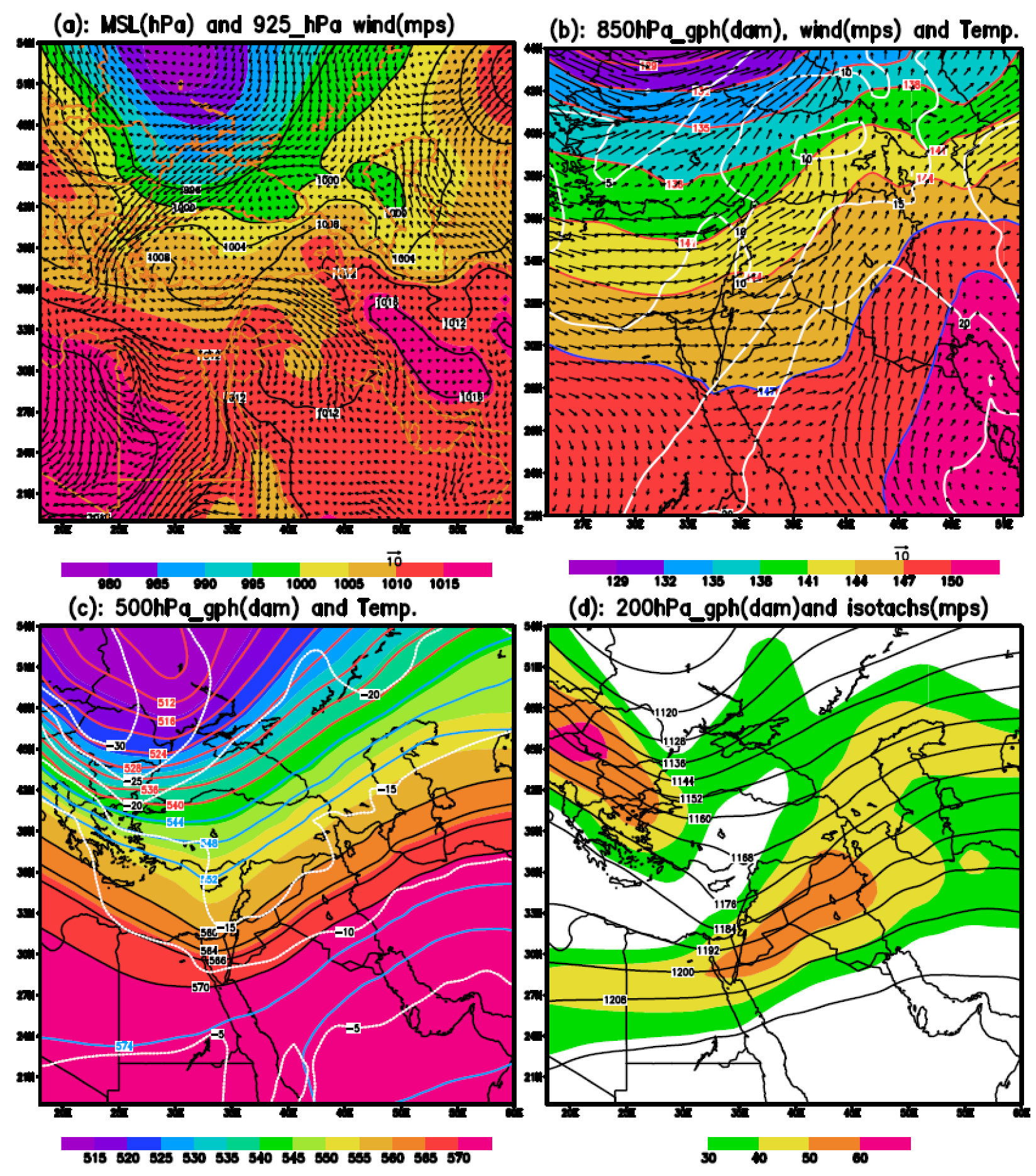
References
- Middleton, N. Variability, and trends in dust storm frequency on decadal timescales: Climatic drivers and human impacts. Geosciences 2019, 9, 261. [Google Scholar] [CrossRef] [Green Version]
- Goudie, A.S. Dust storms and human health. In Extreme Weather Events and Human Health; Springer: Cham, Switzerland, 2020; pp. 13–24. [Google Scholar]
- Middleton, N.J. Desert dust hazards: A global review. Aeolian Res. 2017, 24, 53–63. [Google Scholar] [CrossRef]
- Baddock, M.C.; Strong, C.L.; Murray, P.S.; McTainsh, G.H. Aeolian dust as a transport hazard. Atmos. Environ. 2013, 71, 7–14. [Google Scholar] [CrossRef] [Green Version]
- Stefanski, R.; Sivakumar, M.V.K. Impacts of sand and dust storms on agriculture and potential agricultural applications of an SDSWS. In Proceedings of the IOP Conference Series: Earth and Environmental Science, Barcelona, Spain, 7–9 November 2007; IOP Publishing: Bristol, UK, 2009; Volume 7, p. 012016. [Google Scholar]
- Schutz, L. Saharan dust transport over the North Atlantic Ocean. Geol. Soc. Am. Spec. Paper 1981, 186, 87–100. [Google Scholar]
- Schlesinger, P.; Mamane, Y.; Grishkan, I. Transport of microorganisms to Israel during Saharan dust events. Aerobiologia 2006, 22, 259. [Google Scholar] [CrossRef]
- Middleton, N. Deserts: A Very Short Introduction; Oxford University Press: Oxford, UK, 2009; Volume 215. [Google Scholar]
- Kok, J.F.; Adebiyi, A.A.; Albani, S.; Balkanski, Y.; Checa-Garcia, R.; Chin, M.; Colarco, P.R.; Hamilton, D.S.; Huang, Y.; Ito, A.; et al. Contribution of the world’s main dust source regions to the global cycle of desert dust. Atmos. Chem. Phys. Discuss. 2021, 21, 8169–8193. [Google Scholar] [CrossRef]
- Bullard, J.E.; Harrison, S.P.; Baddock, M.C.; Drake, N.; Gill, T.E.; McTainsh, G.; Sun, Y. Preferential dust sources: A geomorphological classification designed for use in global dust-cycle models. J. Geophys. Res. 2011, 116, F04034. [Google Scholar] [CrossRef] [Green Version]
- Micklin, P. The Aral Sea disaster. Annu. Rev. Earth Planet. Sci. 2007, 35, 47–72. [Google Scholar] [CrossRef] [Green Version]
- Indoitu, R.; Kozhoridze, G.; Batyrbaeva, M.; Vitkovskaya, I.; Orlovsky, N.; Blumberg, D.; Orlovsky, L. Dust emission and environmental changes in the dried bottom of the Aral Sea. Aeolian Res. 2015, 17, 101–115. [Google Scholar] [CrossRef]
- Opp, C.; Groll, M.; Aslanov, I.; Lotz, T.; Vereshagina, N. Aeolian Dust Deposition in the Southern Aral Sea Region (Uzbekistan): Ground-based monitoring results from the LUCA project. Quat. Int. 2017, 429, 86–99. [Google Scholar] [CrossRef]
- Hamzeh, N.H.; Karami, S. Investigation of a Severe Dust Storm over the Aral Sea Area; MegaPrint Inc.: Holderness, NH, USA, 2017. [Google Scholar]
- Gholampour, A.; Nabizadeh, R.; Hassanvand, M.S.; Taghipour, H.; Nazmara, S.; Mahvi, A.H. Characterization of saline dust emission resulted from Lake Urmia drying. J. Environ. Health Sci. Eng. 2015, 13, 82. [Google Scholar] [CrossRef] [PubMed] [Green Version]
- Goudie, A. Dust storms and ephemeral lakes. Desert 2018, 23, 153–164. [Google Scholar]
- Boroughani, M.; Hashemi, H.; Hosseini, S.H.; Pourhashemi, S.; Berndtsson, R. Desiccating Lake Urmia: A new dust source of regional importance. IEEE Geosci. Remote Sens. Lett. 2019, 17, 1483–1487. [Google Scholar] [CrossRef]
- Alizade Govarchin Ghale, Y.; Baykara, M.; Unal, A. Analysis of decadal land cover changes and salinization in Lake Urmia Basin using remote sensing techniques. Nat. Hazards Earth Syst. Sci. Discuss. 2017, 1–15. [Google Scholar] [CrossRef]
- Zoljoodi, M.; Didevarasl, A. Water-level fluctuations of Urmia Lake: Relationship with the long-term changes of meteorological variables (solutions for water-crisis management in Lake Urmia Basin). Atmos. Clim. Sci. 2014, 4, 47665. [Google Scholar] [CrossRef] [Green Version]
- Sattari, M.T.; Mirabbasi, R.; Jarhan, S.; Shaker Sureh, F.; Ahmad, S. Trend and abrupt change analysis in water quality of Urmia Lake in comparison with changes in lake water level. Environ. Monitor. Assess. 2020, 192, 623. [Google Scholar] [CrossRef]
- Sotoudeheian, S.; Salim, R.; Arhami, M. Impact of Middle Eastern dust sources on PM10 in Iran: Highlighting the impact of Tigris-Euphrates basin sources and desiccation. J. Geophys. Res. Atmos. 2016, 121, 14–18. [Google Scholar] [CrossRef]
- Brazel, A.J.; Nickling, W.G. The relationship of weather types to dust storm generation in Arizona (1965–1980). J. Climatol. 1986, 6, 255–275. [Google Scholar] [CrossRef]
- Carlson, T.N.; Benjamin, S.G. Radiative heating rates for Saharan dust. J. Atmos. Sci. 1980, 37, 193–213. [Google Scholar] [CrossRef] [Green Version]
- Offer, Z.I.; Goossens, D. Airborne dust in the Northern Negev Desert (January–December 1987): General occurrence and dust concentration measurements. J. Arid Environ. 1990, 18, 1–19. [Google Scholar] [CrossRef]
- Nickovic, S. Modeling of dust process for the Saharan and Mediterranean area. In The Impact of Desert Dust across the Mediterranean; Springer: Dordrecht, The Netherlands, 1996; pp. 15–23. [Google Scholar]
- Nickovic, S.; Dobricic, S. A model for long-range transport of desert dust. Mon. Weather Rev. 1996, 124, 2537. [Google Scholar] [CrossRef] [Green Version]
- Huneeus, N.; Schulz, M.; Balkanski, Y.; Griesfeller, J.; Prospero, J.; Kinne, S.; Bauer, S.; Boucher, O.; Chin, M.; Dentener, F.; et al. Global dust model intercomparison in AeroCom phase I. Atmos. Chem. Phys. 2011, 11, 7781–7816. [Google Scholar] [CrossRef] [Green Version]
- Pérez, C.; Haustein, K.; Janjic, Z.; Jorba, O.; Huneeus, N.; Baldasano, J.M.; Black, T.; Basart, S.; Nickovic, S.; Miller, R.L.; et al. Atmospheric dust modeling from meso to global scales with the online NMMB/BSC-Dust model–Part 1: Model description, annual simulations and evaluation. Atmos. Chem. Phys. 2011, 11, 13001–13027. [Google Scholar] [CrossRef] [Green Version]
- Shao, Y. A model for mineral dust emission. J. Geophys. Res. Atmos. 2001, 106, 20239–20254. [Google Scholar] [CrossRef]
- Tegen, I.; Harrison, S.P.; Kohfeld, K.; Prentice, I.C.; Coe, M.; Heimann, M. Impact of vegetation and preferential source areas on global dust aerosol: Results from a model study. J. Geophys. Res. Atmos. 2002, 107, AAC-14. [Google Scholar] [CrossRef] [Green Version]
- Kim, D.; Chin, M.; Kemp, E.M.; Tao, Z.; Peters-Lidard, C.D.; Ginoux, P. Development of high-resolution dynamic dust source function-A case study with a strong dust storm in a regional model. Atmos. Environ. 2017, 159, 11–25. [Google Scholar] [CrossRef]
- Tanaka, T.Y.; Chiba, M. A numerical study of the contributions of dust source regions to the global dust budget. Glob. Planet. Change 2006, 52, 88–104. [Google Scholar] [CrossRef]
- Hamzeh, N.H.; Karami, S.; Opp, C.; Fattahi, E.; Jean-François, V. Spatial and temporal variability in dust storms in the Middle East, 2002–2018: Three case studies in July 2009. Arab. J. Geosci. 2021, 14, 538. [Google Scholar] [CrossRef]
- Karami, S.; Hamzeh, N.H.; Abadi, A.R.S.; Madhavan, B.L. Investigation of a severe frontal dust storm over the Persian Gulf in February 2020 by CAMS model. Arab. J. Geosci. 2021, 14, 2041. [Google Scholar] [CrossRef]
- Kallos, G.; Papadopoulos, A.; Katsafados, P.; Nickovic, S. Transatlantic Saharan dust transport: Model simulation and results. J. Geophys. Res. Atmos. 2006, 111, D09204. [Google Scholar] [CrossRef] [Green Version]
- Gong, S.L.; Zhang, X.Y.; Zhao, T.L.; McKendry, I.G.; Jaffe, D.A.; Lu, N.M. Characterization of soil dust aerosol in China and its transport and distribution during 2001 ACE-Asia: 2. Model simulation and validation. J. Geophys. Res. Atmos. 2003, 108. [Google Scholar] [CrossRef]
- Ginoux, P.; Prospero, J.M.; Torres, O.; Chin, M. Long-term simulation of global dust distribution with the GOCART model: Correlation with North Atlantic Oscillation. Environ. Model. Softw. 2004, 19, 113–128. [Google Scholar] [CrossRef]
- Yue, X.; Wang, H.; Wang, Z.; Fan, K. Simulation of dust aerosol radiative feedback using the Global Transport Model of Dust: 1. Dust cycle and validation. J. Geophys. Res. Atmos. 2009, 114. [Google Scholar] [CrossRef]
- Konsta, D.; Binietoglou, I.; Gkikas, A.; Solomos, S.; Marinou, E.; Proestakis, E.; Basart, S.; García-Pando, C.P.; El-Askary, H.; Amiridis, V. Evaluation of the BSC-DREAM8b regional dust model using the 3D LIVAS-CALIPSO product. Atmos. Environ. 2018, 195, 46–62. [Google Scholar] [CrossRef]
- Sugimoto, N.; Hara, Y.; Shimizu, A.; Yumimoto, K.; Uno, I.; Nishikawa, M. Comparison of surface observations and a regional dust transport model assimilated with lidar network data in Asian dust event of March 29 to April 2, 2007. Sola 2011, 7, 13–16. [Google Scholar] [CrossRef] [Green Version]
- Haustein, K.; Pérez, C.; Baldasano, J.M.; Jorba, O.; Basart, S.; Miller, R.L.; Janjic, Z.; Black, T.; Nickovic, S.; Todd, M.C.; et al. Atmospheric dust modeling from meso to global scales with the online NMMB/BSC-Dust model–Part 2: Experimental campaigns in Northern Africa. Atmos. Chem. Phys. 2012, 12, 2933–2958. [Google Scholar] [CrossRef] [Green Version]
- Mahowald, N.; Albani, S.; Kok, J.F.; Engelstaeder, S.; Scanza, R.; Ward, D.S.; Flanner, M.G. The size distribution of desert dust aerosols and its impact on the Earth system. Aeolian Res. 2014, 15, 53–71. [Google Scholar] [CrossRef] [Green Version]
- Terradellas, E.; Basart, S.; Schulz, M.; Baldasano, J.M.; Morcrette, J.J.; Pejanovic, G.; Menut, L.; Benedetti, A.; Jorba, O.; Nickovic, S.; et al. Intercomparison of dust prediction models in the framework of the WMO SDS-WAS programme. Geophys. Res 2012, 114, D06206. [Google Scholar]
- Balkanlou, K.R.; Müller, B.; Cord, A.F.; Panahi, F.; Malekian, A.; Jafari, M.; Egli, L. Spatiotemporal dynamics of ecosystem services provision in a degraded ecosystem: A systematic assessment in the Urmia Lake basin, Iran. Sci. Total Environ. 2020, 716, 137100. [Google Scholar] [CrossRef]
- Soudi, M.; Ahmadi, H.; Yasi, M.; Hamidi, S.A. Sustainable restoration of Lake Urmia: History, threats, opportunities, and challenges. Eur. Water 2017, 60, 341–347. [Google Scholar]
- Vaheddoost, B.; Aksoy, H. Interaction of groundwater within Lake Urmia Iran. Hydrol. Processes 2018, 32, 3283–3295. [Google Scholar]
- Martha, T.R.; Kerle, N.; Jetten, V.; van Westen, C.J.; Kumar, K.V. Characterizing spectral, spatial, and morphometric properties of landslides for semi-automatic detection using object-oriented methods. Geomorphology 2010, 116, 24–36. [Google Scholar] [CrossRef]
- Sima, S.; Ahmadalipour, A.; Shafiee Jood, M.; Tajrishy, M.; Abrishamchi, A. Monitoring Lake Urmia Area Variations Using MODIS Satellite Data. In Proceedings of the World Environmental and Water Resources Congress 2012: Crossing Boundaries, Albuquerque, NM, USA, 20–24 May 2012; ASCE: Reston, VA, USA, 2012; pp. 1917–1926. [Google Scholar]
- Available online: https://giovanni.gsfc.nasa.gov (accessed on 10 November 2021).
- Habibi, M.; Babaeian, I.; Schöner, W. Changing Causes of Drought in Lake Urmia Basin—Increasing Influence of Evaporation and Disappearing Snow Cover. Water 2021, 13, 3273. [Google Scholar] [CrossRef]
- McNally, A.; Arsenault, K.; Kumar, S.; Shukla, S.; Peterson, P.; Wang, S.; Funk, C.; Peters-Lidard, C.D.; Verdin, J.P. A land data assimilation system for sub-Saharan Africa food and water security applications. Sci. Data 2017, 4, 170012. [Google Scholar] [CrossRef] [PubMed] [Green Version]
- Available online: https://sds-was.aemet.es/forecast-products/dust-forecasts (accessed on 12 October 2021).
- Basart, S.; Terradellas, E.; Cuevas, E.; Jorba, O.; Benincasa, F.; Baldasano, J.M. The Barcelona Dust Forecast Center: The first WMO regional meteorological center specialized in atmospheric sand and dust forecast. In Proceedings of the EGU General Assembly Conference Abstracts, Vienna, Austria, 2–17 April 2015; p. 13309. [Google Scholar]
- Nikfal, A.; Saadatabadi, A.R.; Rahnama, M.; Tajbakhsh, S.; Moradi, M. Intercomparisons of some dust models over West Asia. In E3S Web of Conferences; EDP Sciences: Paris, France, 2019; Volume 99, p. 01012. [Google Scholar]
- Karami, S.; Hamzeh, N.H.; Noori, F.; Abadi, A.R.S. Investigation of dust storms in Ilam and the performance analysis of simulation of 6 numerical prediction models at a severe dust storm in the west of Iran. J. Air Pollut. Health 2019, 4, 133–146. [Google Scholar] [CrossRef]
- Karami, S.; Hamzeh, N.H.; Kaskaoutis, D.G.; Rashki, A.; Alam, K.; Ranjbar, A. Numerical simulations of dust storms originated from dried lakes in central and southwest Asia: The case of the Aral Sea and Sistan Basin. Aeolian Res. 2021, 50, 100679. [Google Scholar] [CrossRef]
- Hamzeh, N.H.; Karami, S.; Kaskaoutis, D.G.; Tegen, I.; Moradi, M.; Opp, C. Atmospheric dynamics and numerical simulations of six frontal dust storms in the Middle East region. Atmosphere 2021, 12, 125. [Google Scholar] [CrossRef]
- Mircea, M.; D’Isidoro, M.; Maurizi, A.; Vitali, L.; Monforti, F.; Zanini, G.; Tampieri, F. A comprehensive performance evaluation of the air quality model BOLCHEM to reproduce the ozone concentrations over Italy. Atmos. Environ. 2008, 42, 1169–1185. [Google Scholar] [CrossRef]
- Maurizi, A.; D’Isidoro, M.; Mircea, M. BOLCHEM: An integrated system for atmospheric dynamics and composition. In Integrated Systems of Meso-Meteorological and Chemical Transport Models; Springer: Berlin/Heidelberg, Germany, 2010; pp. 89–94. [Google Scholar]
- Buzzi, A.; D’isidoro, M.; Davolio, S. A case study of an orographic cyclone south of the Alps during the MAP SOP. Q. J. R. Meteorol. Soc. 2003, 129, 1795–1818. [Google Scholar] [CrossRef]
- Nickovic, S.; Kallos, G.; Papadopoulos, A.; Kakaliagou, O. A model for prediction of desert dust cycle in the atmosphere. J. Geophys. Res. Atmos. 2001, 106, 18113–18129. [Google Scholar] [CrossRef] [Green Version]
- Tegen, I.; Fung, I. Modeling of mineral dust in the atmosphere: Sources, transport, and optical thickness. J. Geophys. Res. Atmos. 1994, 99, 22897–22914. [Google Scholar] [CrossRef]
- Janjic, Z.I.; Gerrity, J.P.; Nickovic, S. An alternative approach to non-hydrostatic modeling. Mon. Weather Rev. 2001, 129, 1164–1178. [Google Scholar] [CrossRef]
- Ginoux, P.; Chin, M.; Tegen, I.; Prospero, J.M.; Holben, B. Sources and distributions of dust aerosols simulated with the GOCART model. J. Geophys. Res. 2001, 106, 20255–20273. [Google Scholar] [CrossRef]
- Shao, Y.; Raupach, M.R.; Findlater, P.A. Effect of saltation bombardment on the entrainment of dust by wind. J. Geophys. Res. Atmos. 1993, 98, 12719–12726. [Google Scholar] [CrossRef] [Green Version]
- Janjić, Z.I. The step-mountain eta coordinate model: Further developments of the convection, viscous sublayer, and turbulence closure schemes. Mon. Weather Rev. 1994, 122, 927–945. [Google Scholar] [CrossRef] [Green Version]
- Marticorena, B.; Bergametti, G. Modeling the atmospheric dust cycle: 1. Design of a soil-derived dust emission scheme. J. Geophys. Res. Atmos. 1995, 100, 16415–16430. [Google Scholar] [CrossRef] [Green Version]
- Grell, G.A.; Peckham, S.E.; Schmitz, R.; McKeen, S.A.; Frost, G.; Skamarock, W.C.; Eder, B. Fully coupled “online” chemistry within the WRF model. Atmos. Environ. 2005, 39, 6957–6975. [Google Scholar] [CrossRef]
- Abbasian, M.S.; Najafi, M.R.; Abrishamchi, A. Increasing risk of meteorological drought in the Urmia Lake basin under climate change: Introducing the precipitation–temperature deciles index. J. Hydrol. 2021, 592, 125586. [Google Scholar] [CrossRef]
- Ravan, P.; Ahmady-Birgani, H.; Sorooshian, A. Spatial Mapping of Elemental Variabilities of Atmospheric Particulates throughout the Basin. J. Earth Space Phys. 2019, 45, 667–686. [Google Scholar]
- Gholampour, A.; Nabizadeh, R.; Naseri, S.; Yunesian, M.; Taghipour, H.; Rastkari, N.; Nazmara, S.; Faridi, S.; Mahvi, A.H. Exposure and health impacts of outdoor particulate matter in two urban and industrialized areas of Tabriz, Iran. J. Environ. Health Sci. Eng. 2014, 12, 127. [Google Scholar] [CrossRef] [Green Version]
- Xu, X.; Levy, J.K.; Zhaohui, L.; Hong, C. An investigation of sand–dust storm events and land surface characteristics in China using NOAA NDVI data. Glob. Planet. Chang. 2006, 52, 182–196. [Google Scholar] [CrossRef]
- Lee, J.J.; Kim, C.H. Roles of surface wind, NDVI, and snow cover in the recent changes in Asian dust storm occurrence frequency. Atmos. Environ. 2012, 59, 366–375. [Google Scholar] [CrossRef]
- Hamzeh, N.H.; Kaskaoutis, D.G.; Rashki, A.; Mohammadpour, K.B. Long-Term Variability of Dust Events in Southwestern Iran and Its Relationship with the Drought. Atmosphere 2021, 12, 1350. [Google Scholar] [CrossRef]
- Mardi, A.H.; Khaghani, A.; MacDonald, A.B.; Nguyen, P.; Karimi, N.; Heidary, P.; Karimi, N.; Saemian, P.; Sehatkashani, S.; Tajrishy, M.; et al. The Lake Urmia environmental disaster in Iran: A look at aerosol pollution. Sci. Total Environ. 2018, 633, 42–49. [Google Scholar] [CrossRef] [PubMed]
- Delfi, S.; Mosaferi, M.; Hassanvand, M.S.; Maleki, S. Investigation of aerosol pollution across the eastern basin of Lake Urmia using satellite remote sensing data and HYSPLIT model. J. Environ. Health Sci. Eng. 2019, 17, 1107–1120. [Google Scholar] [CrossRef] [PubMed]
- Moghim, S.; Ramezanpoor, R. Characterization of aerosol types over the lake Urmia Basin. In E3S Web of Conferences; EDP Sciences: Paris, France, 2019; Volume 99, p. 01006. [Google Scholar]
- Ahmady-Birgani, H.; Ravan, P.; Schlosser, J.S.; Cuevas-Robles, A.; AzadiAghdam, M.; Sorooshian, A. On the chemical nature of wet deposition over a major desiccated lake: A case study for the Lake Urmia basin. Atmos. Res. 2020, 234, 104762. [Google Scholar] [CrossRef]
- Dehghani, M.H.; Hopke, P.K.; Asghari, F.B.; Mohammadi, A.A.; Yousefi, M. The effect of the decreasing level of Lake Urmia on particulate matter trends and attributed health effects in Tabriz, Iran. Microchem. J. 2020, 153, 104434. [Google Scholar] [CrossRef]
- Rashki, A.; Middleton, N.J.; Goudie, A.S. Dust storms in Iran–Distribution, causes, frequencies, and impacts. Aeolian Res. 2021, 48, 100655. [Google Scholar] [CrossRef]
- Boueshagh, M.; Hasanlou, M. Estimating Water Level in Lake Urmia Using Satellite Data: A Machine Learning Approach. Int. Arch. Photogramm. Remote Sens. Spat. Inf. Sci. 2019, 42, 219–226. [Google Scholar] [CrossRef] [Green Version]
- Rashki, A.; Kaskaoutis, D.G.; Sepehr, A. Statistical evaluation of the dust events at selected stations in Southwest Asia: From the Caspian Sea to the Arabian Sea. Catena 2018, 165, 590–603. [Google Scholar] [CrossRef]
- Notaro, M.; Alkolibi, F.; Fadda, E.; Bakhrjy, F. Trajectory analysis of Saudi Arabian dust storms. J. Geophys. Res. Atmos. 2013, 118, 6028–6043. [Google Scholar] [CrossRef]
- Nabavi, S.O.; Haimberger, L.; Samimi, C. Sensitivity of WRF-chem predictions to dust source function specification in West Asia. Aeolian Res. 2017, 24, 115–131. [Google Scholar] [CrossRef]
- Abuduwaili, J.; Liu, D.; Wu, G. Saline dust storms and their ecological impacts in arid regions. J. Arid Land 2010, 2, 144–150. [Google Scholar] [CrossRef] [Green Version]
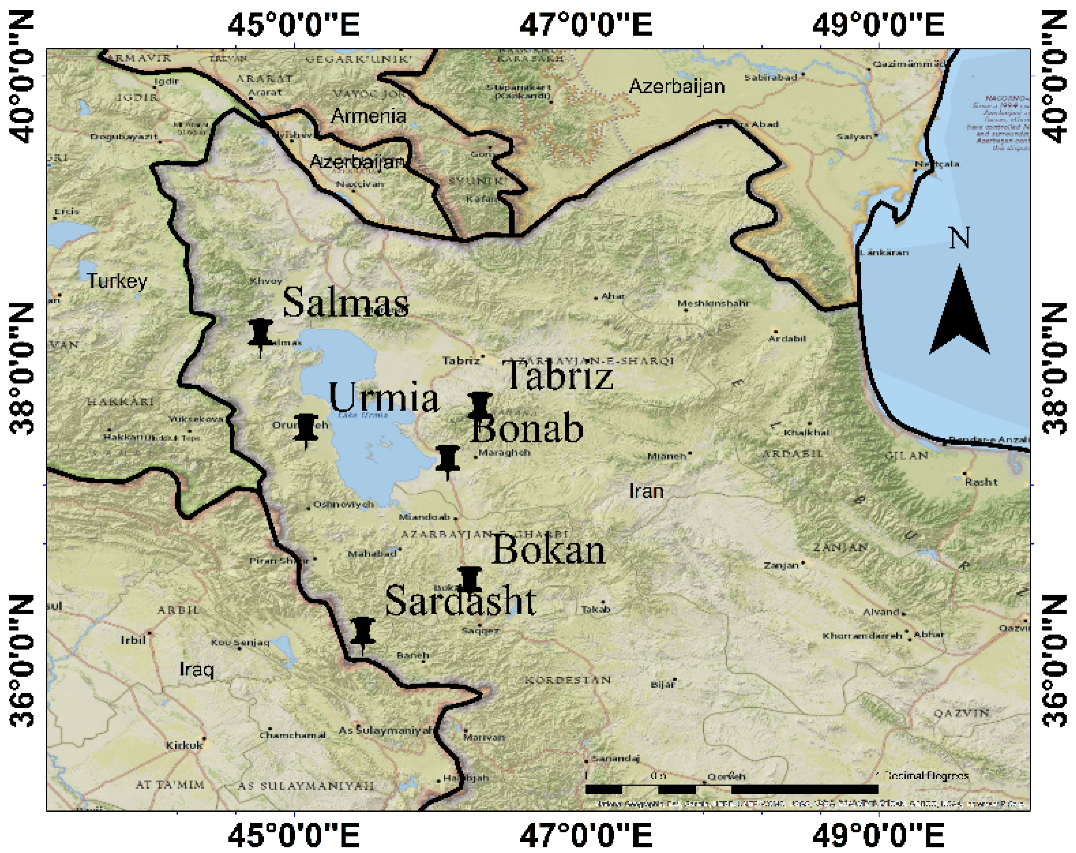
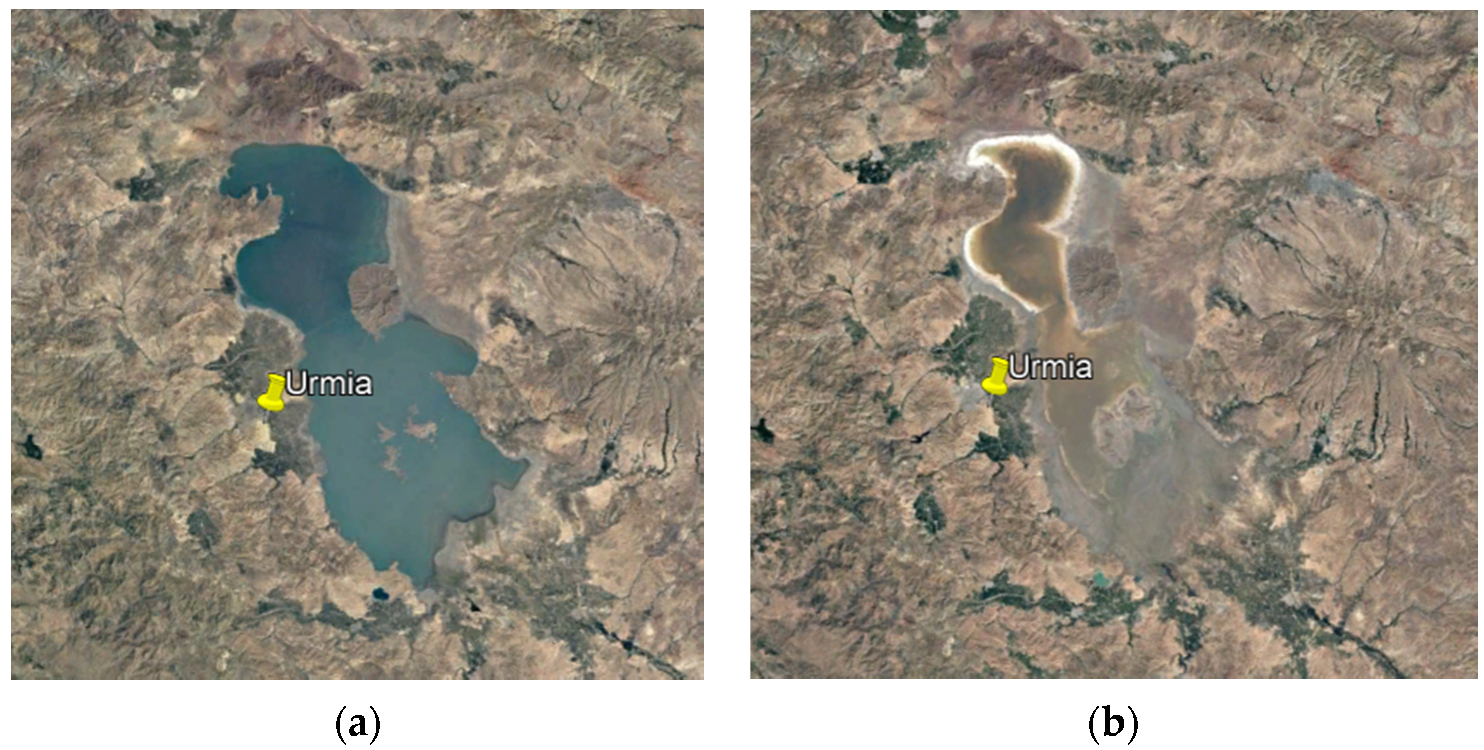
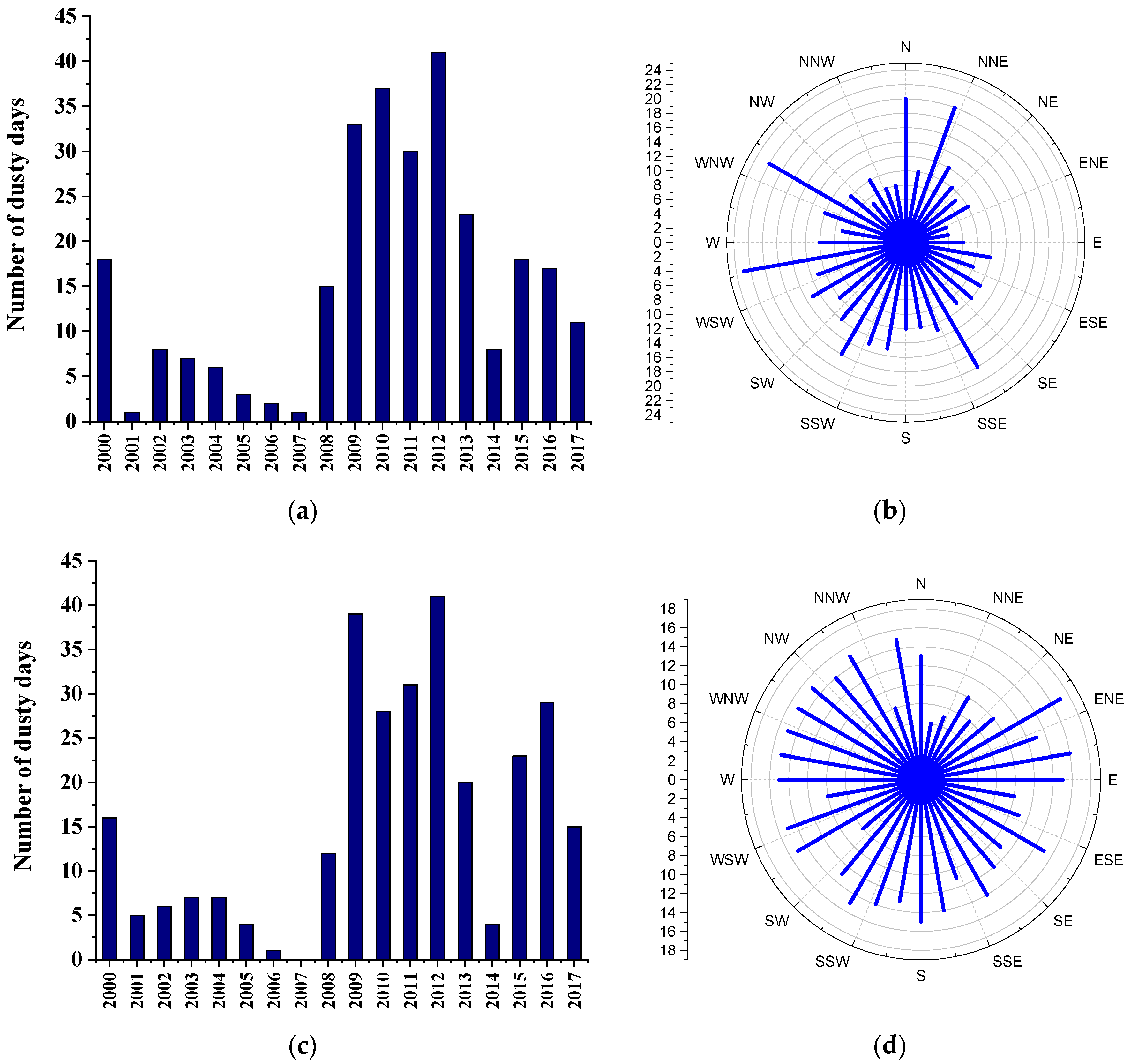
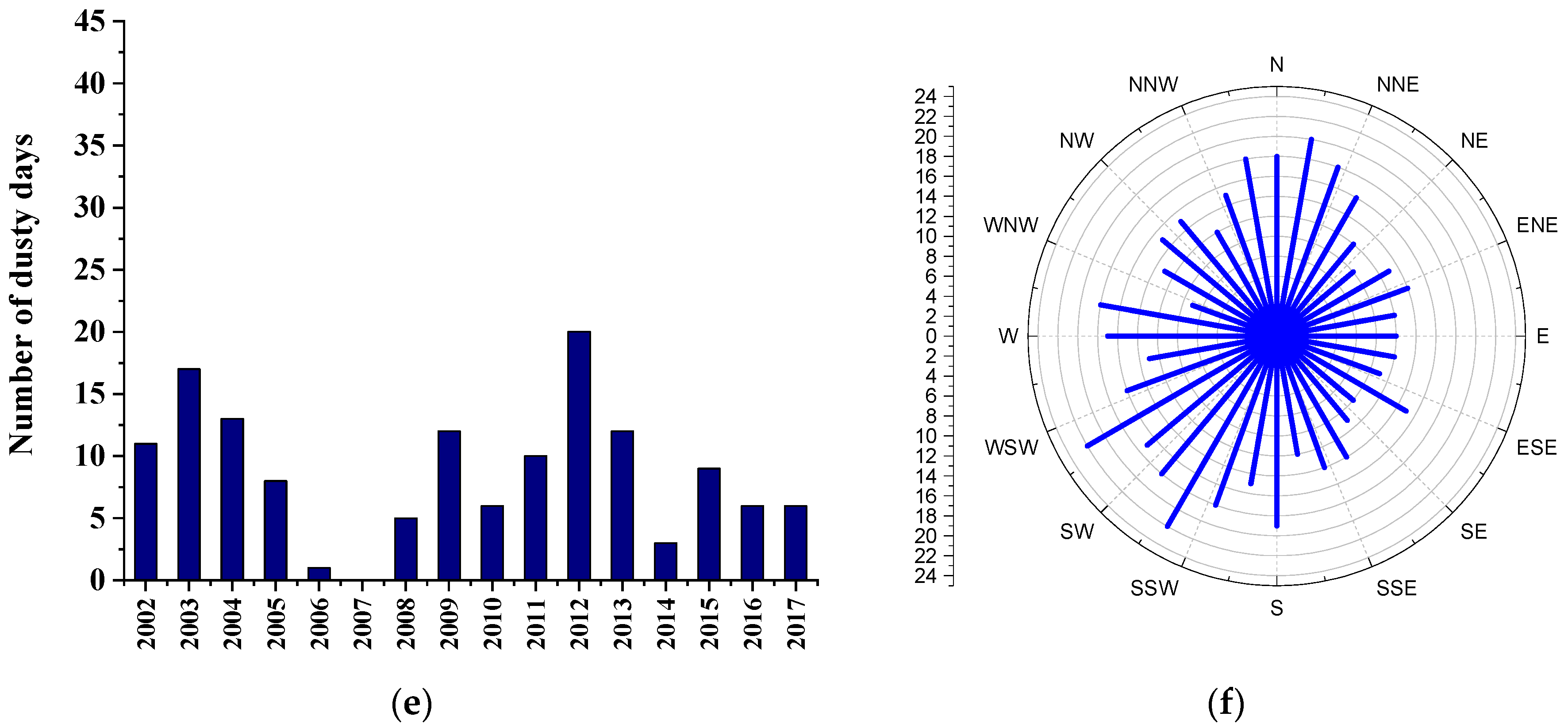
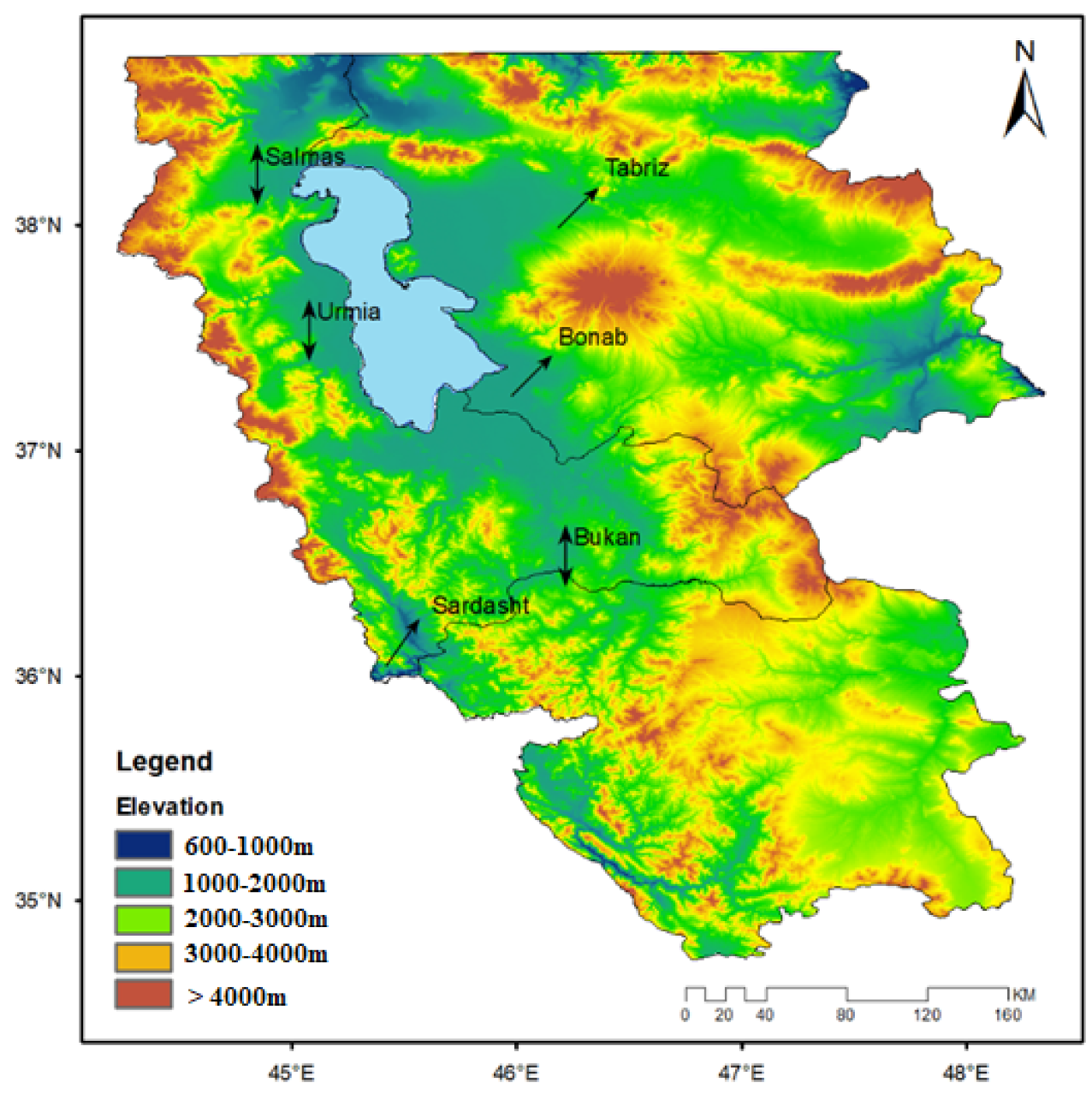
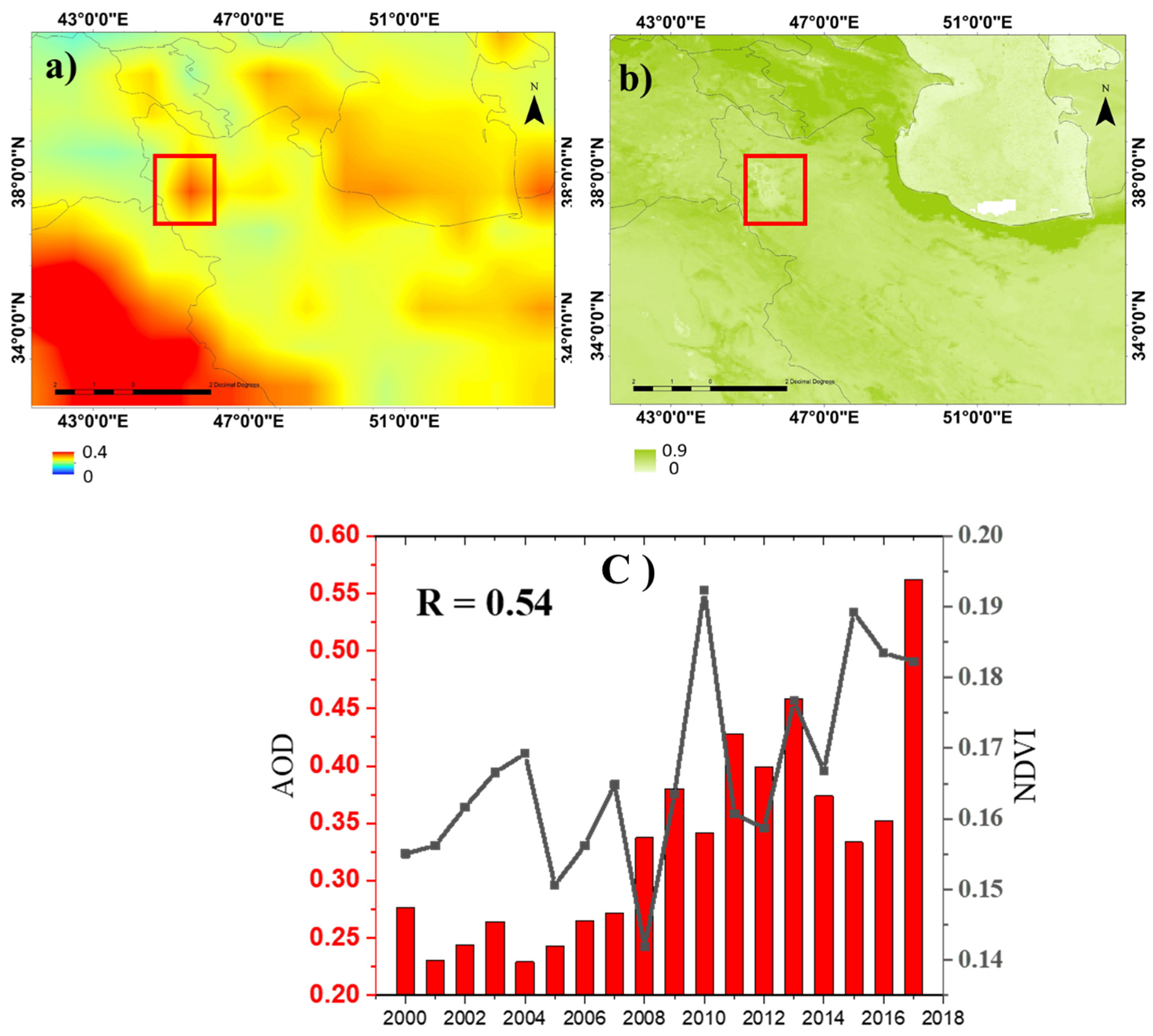
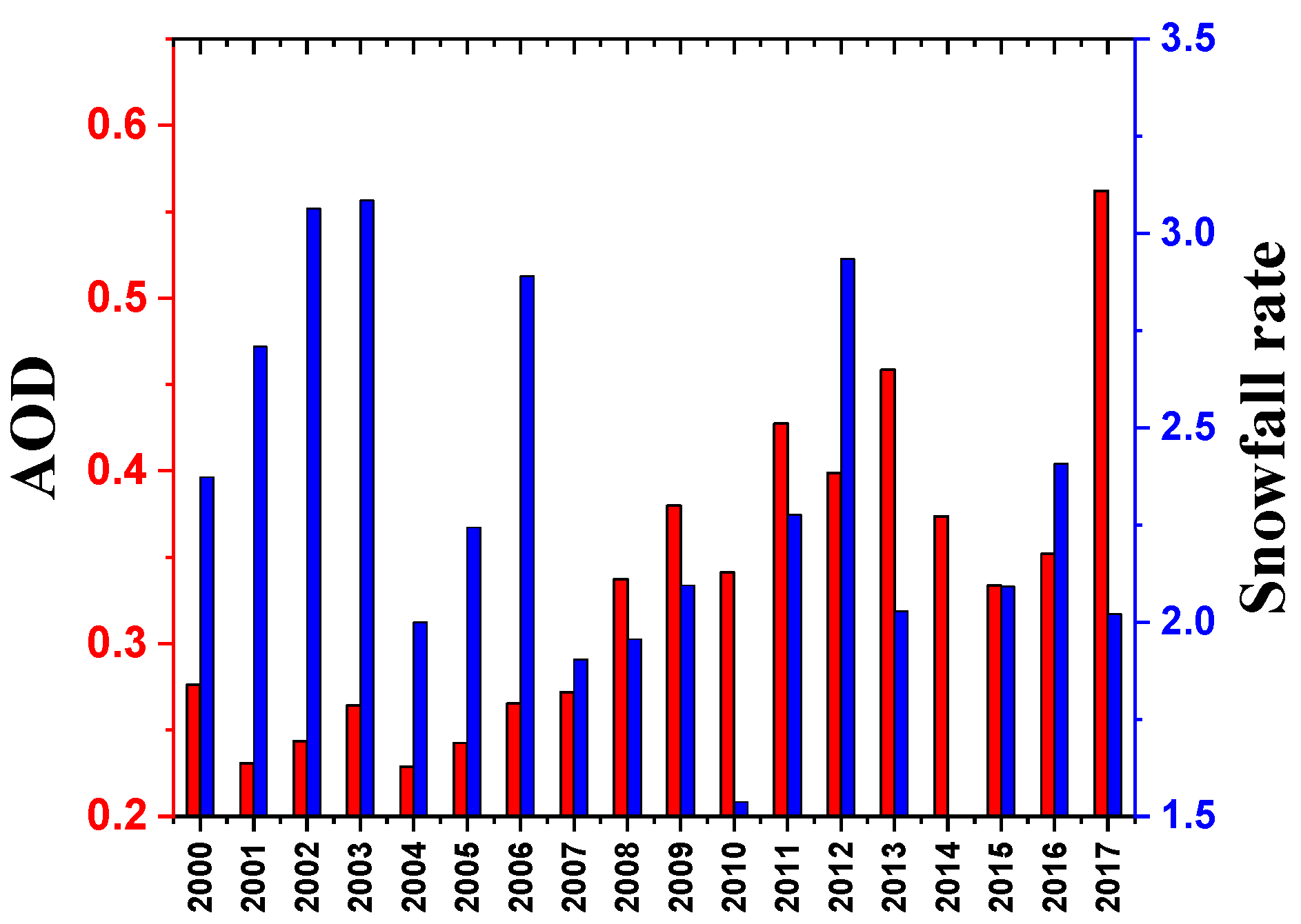

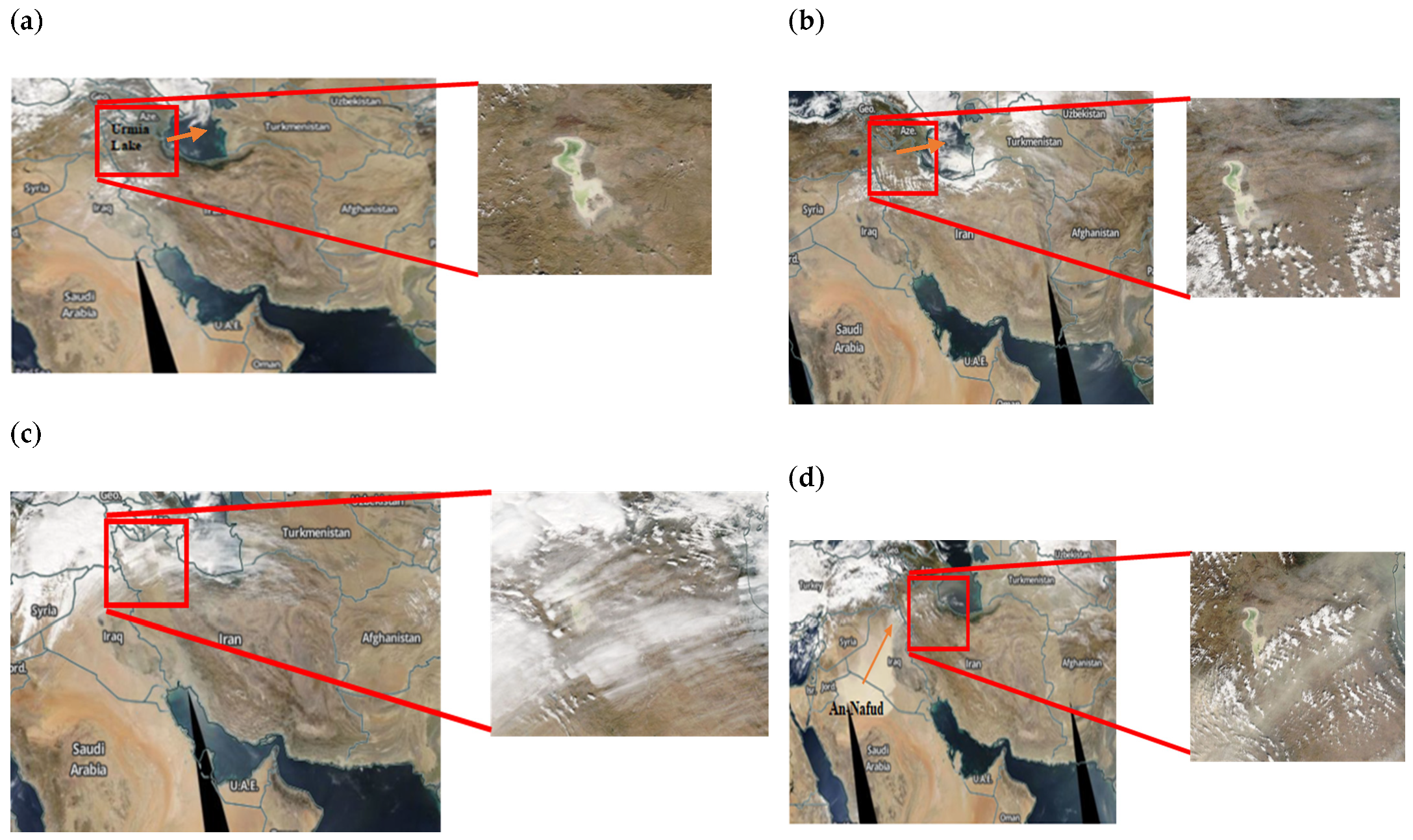
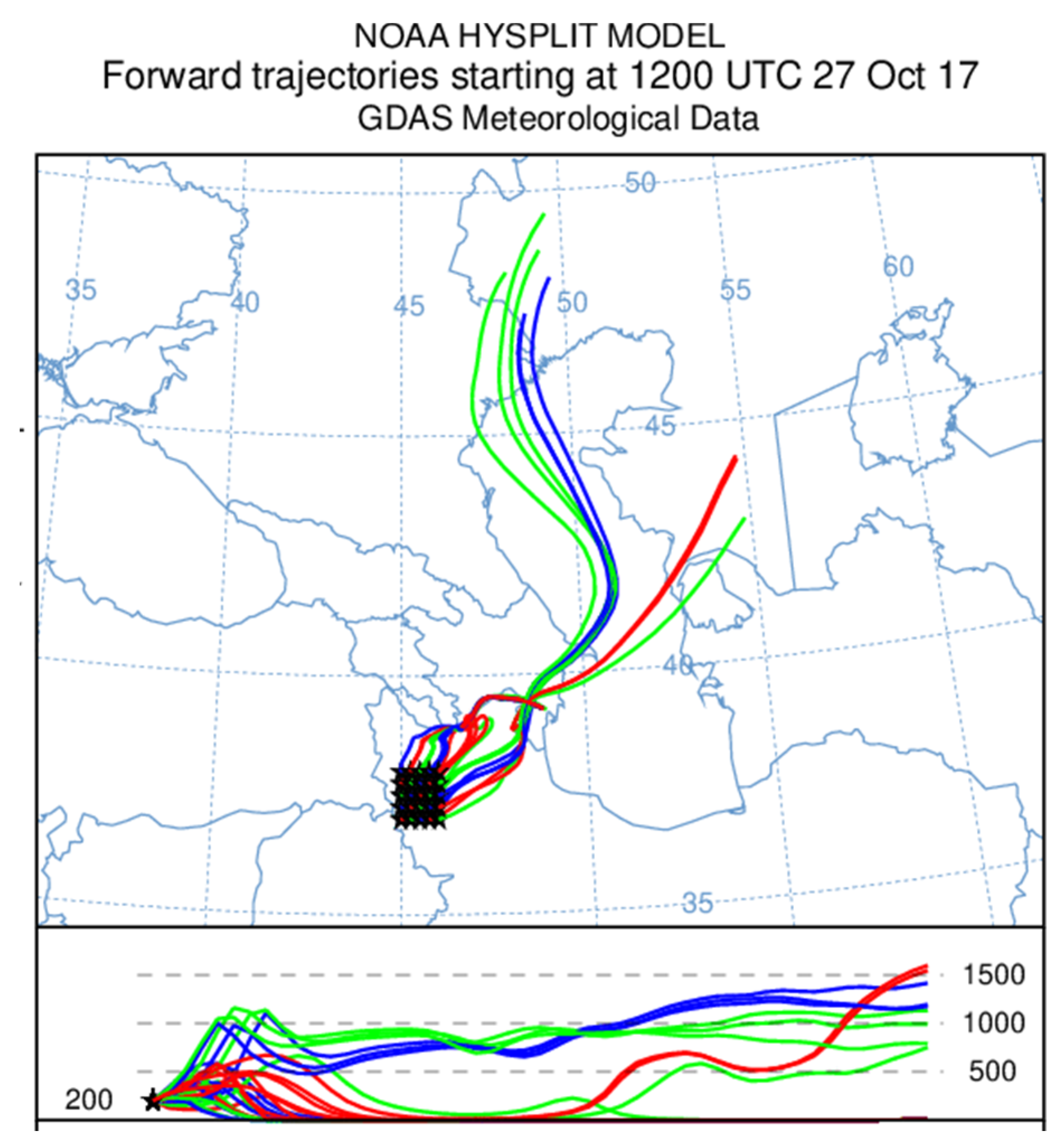
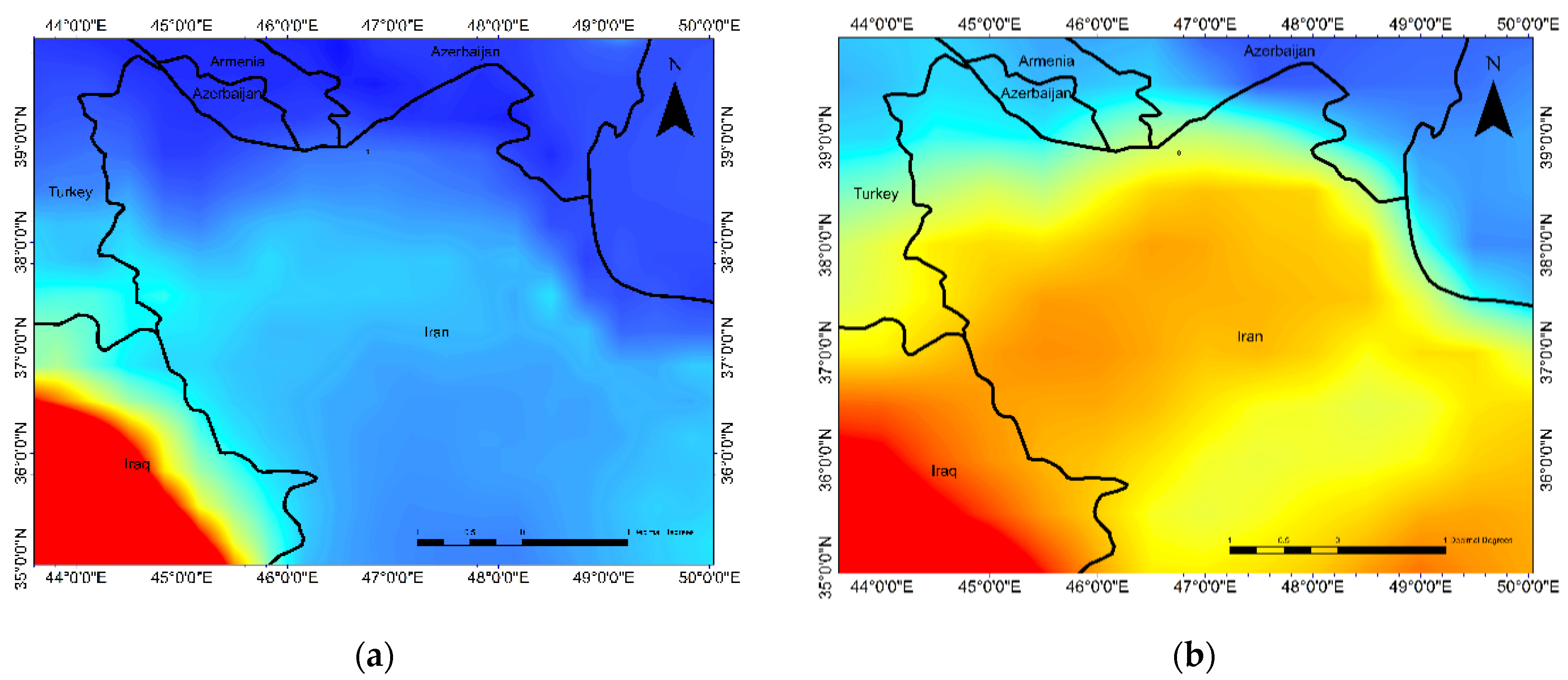
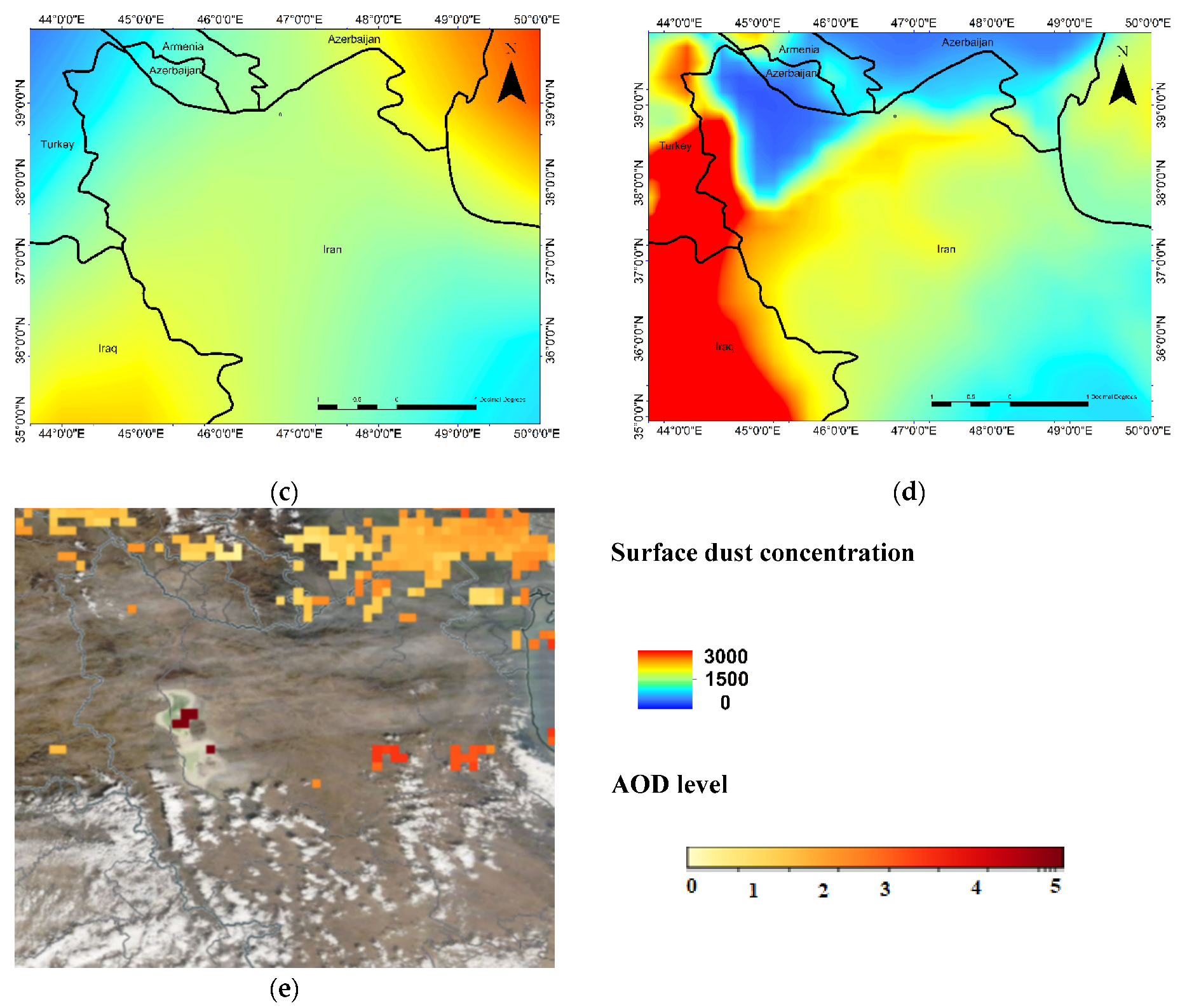
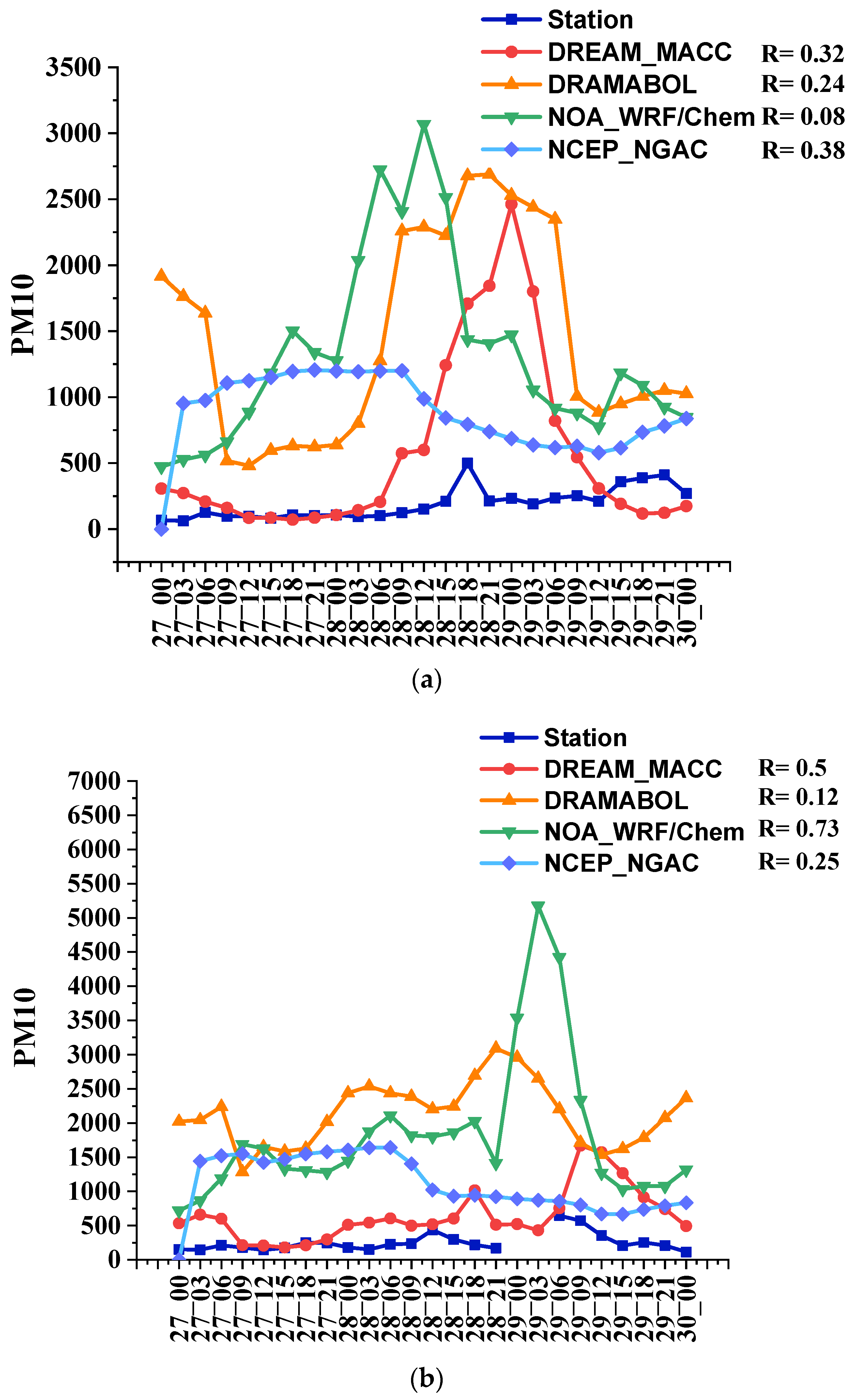
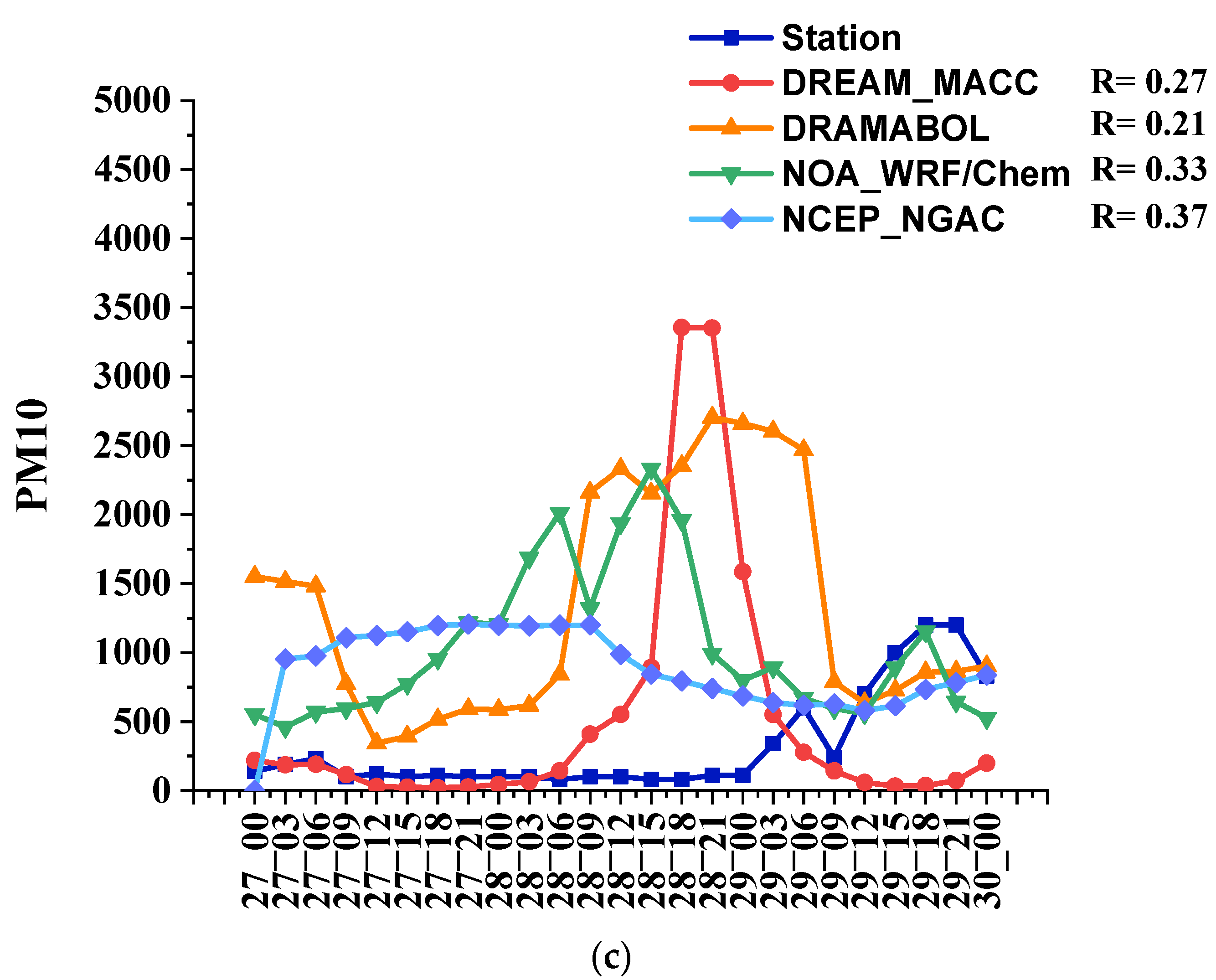
| Synoptic Station | Longitude | Latitude | Elevation | Mean Number of Dust Days |
|---|---|---|---|---|
| Urmia | 45.08 | 37.55 | 1328 | 15.5 |
| Tabriz | 46.27 | 35.7 | 1361 | 33.11 |
| Salmas | 44.77 | 38.02 | 1339.3 | 8.7 |
| Bonab | 46.05 | 37.34 | 1281 | 16 |
| Bokan | 46.2 | 36.51 | 1386.1 | 28.07 |
| Sardasht | 45.47 | 36.16 | 1556.8 | 27.55 |
| 06 | Widespread dust in suspension, not raised by wind at or near the station at the time of observation |
| 07 | Dust or sand raised by wind at or near the station at the time of observation |
| 30–32 | Slight or moderate sand storms or dust storms |
| 33–35 | Severe sand storms or dust storms |
| Model | Operator | Meteorological Model | Dust Model, Dust Scheme | Initial Weather Condition (Resolution) | Resolution (Grid Type) |
|---|---|---|---|---|---|
| DREAMABOL | the Institute of Atmospheric Sciences and Climate of Bologna in Italy [58,59] | BOLAM equation hydrostation model [60] | DREAM [61,62] | GFS output (0.5°) | 0.4° (rotated pole lon-lat) |
| DREAM8-NMME-MACC | Southeast European Virtual Climat Change Center, Serbia | DREAM8 model by the NCEP Non-Hydrostatic Mesoscale Model [63], | [65,66] | ECMWF (1.5°) | 1.3° |
| NCEP-NGAC | NOAA National Centers for Environmental Prediction (NCEP), in collaboration with NASA Goddard Space Flight Center (GSFC) | Global Forecast System (GFS) | [66,67] | NCEP GDAS (1°) | 1° |
| NOAA/WRF-Chem | National Observatory of Athens | WRF [68] | GOCART scheme derived from [64] | GFS output (0.5°) | 0.19° |
| Model | DREAM-MACC | DRAMABOL | NOAA/WRF-Chem | NCEP-NGAC |
|---|---|---|---|---|
| Correlation | 0.36 | 0.62 | 0.33 | 0.32 |
| MAE | 344.42 | 1336.77 | 1037.10 | 728.03 |
Publisher’s Note: MDPI stays neutral with regard to jurisdictional claims in published maps and institutional affiliations. |
© 2022 by the authors. Licensee MDPI, Basel, Switzerland. This article is an open access article distributed under the terms and conditions of the Creative Commons Attribution (CC BY) license (https://creativecommons.org/licenses/by/4.0/).
Share and Cite
Hamzeh, N.H.; Ranjbar Saadat Abadi, A.; Chel Gee Ooi, M.; Habibi, M.; Schöner, W. Analyses of a Lake Dust Source in the Middle East through Models Performance. Remote Sens. 2022, 14, 2145. https://doi.org/10.3390/rs14092145
Hamzeh NH, Ranjbar Saadat Abadi A, Chel Gee Ooi M, Habibi M, Schöner W. Analyses of a Lake Dust Source in the Middle East through Models Performance. Remote Sensing. 2022; 14(9):2145. https://doi.org/10.3390/rs14092145
Chicago/Turabian StyleHamzeh, Nasim Hossein, Abbas Ranjbar Saadat Abadi, Maggie Chel Gee Ooi, Maral Habibi, and Wolfgang Schöner. 2022. "Analyses of a Lake Dust Source in the Middle East through Models Performance" Remote Sensing 14, no. 9: 2145. https://doi.org/10.3390/rs14092145
APA StyleHamzeh, N. H., Ranjbar Saadat Abadi, A., Chel Gee Ooi, M., Habibi, M., & Schöner, W. (2022). Analyses of a Lake Dust Source in the Middle East through Models Performance. Remote Sensing, 14(9), 2145. https://doi.org/10.3390/rs14092145







